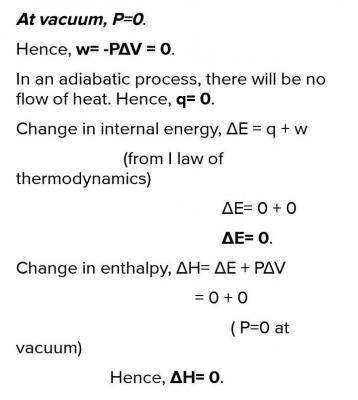The situation obtained when a perfect gas expands into a vacuum is
ΔH is positive and TΔ S is zero
ΔH is positive and T Δ S is negative
ΔH is negative and TΔ S is zero
ΔH is zero and T Δ S is positive
Correct answer is D

The definition of enthalpy change is
ΔH = ΔU + Pex(ΔV)
The enthalpy change is zero because both terms on the right are zero in free expansion of an ideal gas.
There is no external pressure in a free expansion, so P (ex) = 0. And the internal energy change, ΔU of free expansion in a closed system is zero since no inter molecular forces have to be overcome. The temperature remains constant and no heat is absorbed or released.
have no effect on the equilibrium position
increase the rate of both the forward and reverse reactions equally
favour the forward reaction
favour the reverse reaction
Correct answer is C
N\(_{2(g)}\) + 3H\(_{2(g)}\) ⇔ 2NH\(_{3(g)}\) In the Haber process, the forward reaction is exothermic and the backward reaction is endothermic. If the temperature is decreased, the yield from the exothermic direction is increased i.e. the forward reaction is increased.
Sieving is a technique used to separate mixtures containing solid particles of
small sizes
large sizes
different sizes
the same size
Correct answer is C
Sieving is a simple and convenient technique of separating particles of different sizes.
If the molecular mass of tetraoxosulphate (VI) acid is 98, calculate its vapour density.
196
49
106
82
Correct answer is B
Molecular mass = Vapour Density x 2
Vapour Density = \(\frac{\text{Molecular Mass}}{2}\)
Where Molecular mass = 98g/mol
Vapour Density = \(\frac{98}{2}\)
Vapour Density = 49g/mol
Which of these alloys contains copper?
solder
steel
permallory
bronze
Correct answer is D
Bronze is an alloy consisting primarily of copper, commonly with about 12% tin and often with the addition of other metals (such as aluminium, manganese, nickel or zinc) and sometimes non-metals or metalloids such as arsenic, phosphorus or silicon.
JAMB Subjects
Aptitude Tests